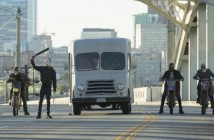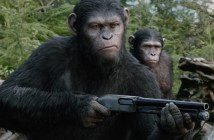
As a follow-up to my list of this topic i 2011, I’m taking stock of the world of acting in the past year in cinema. Nearly every awards body gives out acting awards, but only a handful recognize a Best Cast or Best Ensemble of the year, as distinct from a more all-encompassing Best Picture. Two notable films from the year, Gravity and All is Lost, capitalize on their dual or solo protagonist(s) as the only characters, but nearly every other example relies on the interplay between recognizable stars, character actors, newbies, and extras. Effective ensembles of 2013 came under directors known for orchestrating, even indulging, an unwieldy stable of actors (David O. Russell, Martin Scorsese, Alexander Payne, Woody Allen), as well as filmmakers more known for focused tone in both acting and visuals (Steve McQueen, Denis Villeneuve, Sofia Coppola). The year was also notable for some relatively sensitive coming-of-age films involving large casts of young people and fun entries in ensemble-heavy franchises like Fast & Furious and The Hobbit. Next week I will unveil my own choices, but until then please comment on your own favorites.
 10. This is the End
10. This is the End
Peppered with cameos that work (Bizarro Michael Cera and feisty Emma Watson) and some that don’t (Rihanna?), the directorial debut of Superbad writing duo Seth Rogen and Evan Goldberg is an over-the-top scatological meta free-for-all that fruitfully merges the Judd Apatow house style of improvisatory frat humor (with touches of maudlin masculine self-pity) and apocalyptic horror tropes. The core cast members play fun house mirror versions of themselves, relying on an audience’s knowledge of public personas and previous work. Inasmuch as there’s an emotional core it rests in the tested friendship between Rogen and Jay Baruchel, but the most memorable moments come from the other survivors of the end times: pretentious James Franco, overprotective of the last bastion of normalcy, his palatial mansion; the obsequious then possessed Jonah Hill; the laid-back but earnest Craig Robinson; and finally the manic and boisterous Danny McBride, perhaps outdoing in sheer selfish egotism every other character of his career thus far.
9. The Past
Asghar Farhadi’s A Separation earned the top spot on my Top Ten Ensembles of 2011 list, and while his follow-up The Past is less original and more melodramatic, it still features a remarkable cast of multi-ethnic, multi-generational performers working through a complicated tale of deceit and misunderstanding. Ali Mosaffa plays an Iranian man arriving in Paris to sign divorce papers, forcing him to come to terms with his now ex-wife (recent Oscar winner Bérénice Bejo, emotionally charged) and her volatile new lover (Tahar Rahim of A Prophet). The interactions between children of previous relationships and the nature of the new lover’s comatose wife add to family tensions. Farhadi, as writer and director, has a way of presenting the dialogue and physical confrontations between characters of different ages, backgrounds, and nationalities without ornament or undue emphasis, forcing an audience member to stay alert at all times. The younger performers (Pauline Burlet, Jeanne Jestin, and Elyes Aguis), as in A Separation, are directed particularly sensitively, as victims of circumstance only dimly aware of their agencies and responsibilities in such a trying family dynamic.
 8. Drug War
8. Drug War
One of Johnnie To’s fleetest and most brutal cops and robbers thrillers, the efficiently-titled Drug War features strong ensembles on both sides of the legal line. Straddling that line is the informing drug lord played by Louis Koo, a character with shifting allegiances who remains opaque even to the audience, all the way up to the agonizing conclusion. Much of the film is taut and procedural, outlining the preparations and executions of various maneuvers of the drug enforcement squad against the bigger fish that Koo leads them to. Cooperation and teamwork compete against short-term gain and selfishness, the ensemble against the solo performer. One particular moment of dire consequence involves playacting as a compulsively upbeat low-level dealer, reenacting verbatim a scene just seen; To emphasizes the masquerade, the target’s stone-faced bluff, and the reactions of the other officers watching either in the room or through concealed CCTV, crafting a dynamic mode of ensemble acting rare in action films in particular or in movies in general.
7. Short Term 12
With a mix of professional actors and non-actors, writer-director Destin Cretton brings to life the counselors and charges of a group home for the young victims of emotional and physical trauma and abuse. While the narrative focus is on the twenty- and thirty-something counselors and only a few of the home’s actual members, the rest of the youths still bring a powerful verisimilitude and lived-in quality to scenes of group meetings. Brie Larson anchors the cast as the firm but sensitive head counselor who struggles to keep things running smoothly even as her personal life has its ups and downs. Her boyfriend (John Gallagher, Jr.) could have been a predictable, one-note character but the writer and actor flesh him out with an unfolding, humanizing back story. Extra credit should be given to Kaitlyn Dever and Keith Stanfield as the two most prominent young residents of the home, who reveal their thick-shelled, traumatized inner selves with flashes of humor and artistic passion. Even as melodrama and pat resolutions threaten to betray the frankly insoluble emotional turmoils the film had so deftly navigated, the cast of patient, warmhearted, humane characters leave a lasting impression.
 6. The World’s End
6. The World’s End
The second apocalyptic comedy featuring male camaraderie in the face of annihilation comes from the duo of Simon Pegg and Edgar Wright, finishing up a self-styled trilogy that includes Shaun of the Dead and Hot Fuzz. Like those, The World’s End is a buffet of comedic British performances with a surprisingly heartfelt friendship at the center. After playing affable everyman Shaun and relentless supercop Nicholas Angel, Pegg takes on his most emotionally shaded role yet as perennial fuck-up and arrested adolescent Gary King, who organizes a repeat of an infamous youthful pub crawl with his now grown-up and responsible mates (constant partner Nick Frost, along with Paddy Considine, Eddie Marsan, and Martin Freeman). Their interactions bespeak a close-knit but strained mutual past, and the teasing out of those unresolved tensions keeps things grounded even when synthetic humanoid doubles and a global conspiracy take over the plot. At the edges of the narrative are some other recognizable stalwarts of British cinema, including David Bradley, Michael Smiley, and Pierce Brosnan, as well as Rosamund Pike, the one breath of fresh air in the overwhelmingly masculine environment.
5. The Wolf of Wall Street
Writer Terence Winter and director Martin Scorsese are no strangers to depicting self-enclosed communities of exciting, powerful, testosterone-fueled, and morally questionable individuals. The auteurs behind Boardwalk Empire and GoodFellas, respectively, dive headfirst into the money-crazed, drug-fueled universe of stockbroker Jordan Belfort, inhabited with gusto by Scorsese’s modern go-to star, Leonardo DiCaprio. Belfort surrounds himself with losers and schemers who also want to get rich quick, while manipulating those same feelings in his clients/victims. The alternately sickened and awed fascination with Belfort’s compatriots, including a sleazy Jonah Hill and amoral mentor Matthew McConaughey, turns into sympathy for his various wives (Cristin Milioti and Margot Robbie) and his put-upon, workaday nemesis, investigator Patrick Denham, played with rumpled decency by Kyle Chandler. Even such peripheral characters as Rob Reiner’s blustering voice of reason and a concluding cameo by Belfort himself fit neatly in the vaguely unsettling and comic ecosystem of The Wolf of Wall Street.
 4. Computer Chess
4. Computer Chess
Creatively captured by a Sony AVC3260, an early analog video camera, in suitable black-and-white, indie auteur Andrew Bujalski’s lo-fi/sci-fi depiction of an early 80s computer chess tournament in an urban hotel also evokes the era with its ensemble, down to the clothing, facial hair, and demeanor. While one could consider young inexperienced coder Peter Bishton (Patrick Riester) and rogue “independent programmer” Michael Papageorge (Myles Paige) as kinds of protagonists, Computer Chess is really about a whole community of university techno-utopians and basement-dwelling techno-fetishists at the dawn of the digital age, where the ultimate implications of their experiments would only begin to be discussed. But far from being a dry treatise or history lesson, it relies on the quirks and timing of its unconventional misfit characters, including an EST-like group of New Agers vying with the tournament for hotel space and an inexplicable mob of cats, to make the inherent comic awkwardness come to the fore.
3. Caesar Must Die
The premise of Vittorio and Paolo Taviani’s Caesar Must Die allows contemplation of the ensemble in multiple, overlapping senses: as prisoners in a high-security prison in Rome, convicted of murder, theft, and various connections to organized crime; as performers struggling to bring to life one of Shakespeare’s most iconic tragedies, Julius Caesar; and finally as those historical characters themselves, gradually teasing out the implicit parallels between the real-world inmates and the Bard’s immortal creations. The “play within a film” conceit, typically reserved for musicals or comedy, here uses its documentary quality for a more moral aim, to humanize its figures into possible artists without minimizing their transgressions; indeed, the bloody betrayal and violent, masculine intrigue of Shakespeare’s play seem to provide windows through which the inmates/actors may better recognize and ruminate on their crimes. While each of the main performers gets his own on-screen text laying out his reason for incarceration and length of punishment, so it’s never forgotten what he has done, watching rehearsals, arguments, and a triumphant final performance leaves a sense of wasted potential by growing through artistry.
 2. Inside Llewyn Davis
2. Inside Llewyn Davis
Since their earliest films updating the noir and screwball farce genres, the Coens have had a knack for shaping ensembles of stylized and indelible characters into coherent units. They’ve continued their streak with the 60s folk scene character study Inside Llewyn Davis, which is chock full of their usual quirky yet affecting creations. The story’s center that does not hold is the eponymous musician (Oscar Isaac), a rudderless artist lacking social graces or a crucial sense of commercialism; he’s surrounded by the typical and impeccably-drawn figures of the thriving Greenwich Village, folkies of all shapes and sizes and talent levels. Llewyn’s odyssey to audition for a famous manager in Chicago introduces an acidic John Goodman, stony Garrett Hedlund, and jaded, bemused F. Murray Abraham, but ultimately the journey leads back to the beginning New York community of starving artists. Rounding out the cast of vivid characters are two of recent cinema’s most lovingly-rendered non-humans: Llewyn’s momentary feline companion with the suggestive name of Ulysses, and his more tragic mistaken doppelganger.
1. You Ain’t Seen Nothin’ Yet
Like all of Alain Resnais’s films of the 2000s, You Ain’t Seen Nothin’ Yet boasts a stable of venerable, recognizable stars of the French cinema, most of whom have worked with the director in the past; the wrinkle in the 91-year-old’s latest is that they’re playing incarnations of themselves who, gathered for a memorial of their mutual friend and imaginary playwright Antoine d’Anthac (a framing device from Jean Anouilh’s “Dear Antoine: or, the Love that Failed”), gradually fall under the spell of a filmed interpretation of Anouilh’s “Eurydice” and begin acting out their own parts from the play as the diegetic world shifts around them. Despite the length it takes to merely describe the scenario, Resnais’ troupe is so potent as to make the absurd and fanciful twists seem natural. Multiple actors recite their dialogue in unison, echoing the performance projected before them and turning an age-old myth into the height of modern artifice. The film captures the resonance of seeing several generations reenact the flush of first love and the wide-open potential when theater and cinema converge.



